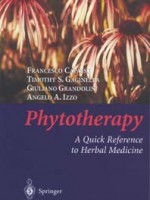Phytotherapy. A quick reference to herbal medicine
- 1 Volumes
- Auteurs : Francesco Capasso, Timothy S. Gaginella, Giuliano Grandolini, Angelo A. Izzo
- Edition : Berlin, Springer Verlag
- Langues : Anglais
- Mot-clés : Pharmacognosie, Pharmatoxicologie, Phytothérapie, Plantes médicinales
Description :
About 30% of all prescriptions issued in the USA, Canada and Europe contain either a herb, a purified extract or an active component derived from herbs. However, medical practitioners are often confused by conflicting information available on the safety and efficacy of herbs; herbal medicines are often co-prescribed without proper attention to adjustment of dosages.
This reference guide treats the subject of herbal medicines in an integrated fashion with reference to pharmacognosy, pharmacology and toxicology. It will help to enable internists, phytotherapists, physicians, healthcare practitioners as well as students to understand why, when and how herbal medicines can be used in the treatment of diseases.
Contents
Part I
Introduction
Definitions
History
The complexity of herbal medicines
Are the herbal medicines safe?
The herbal medicines and the importance of the scientific research
Parts of the plant to be used, nomenclature, drug acquisition and preservation
Active principles
Therapeutic overview of galenical preparations
Uses of herbal medicines in specific situations
Sources of herbal medicine information
Herbal product regulations
Part II
Plants and the nervous system
Plants and the cardiovascular system
Plants and metabolic diseases
Plants and the renal system
Anti-inflammatory plants
Plants and the respiratory system
Adaptogenic plants
Plants and the reproductive system
Plants and the digestive system
Plants, liver and billary system
Plants and the cutaneous system
Identification guide
Plants
Crude drugs
Appendix
2003, 420 p.
ISBN 3-540-00052-6


